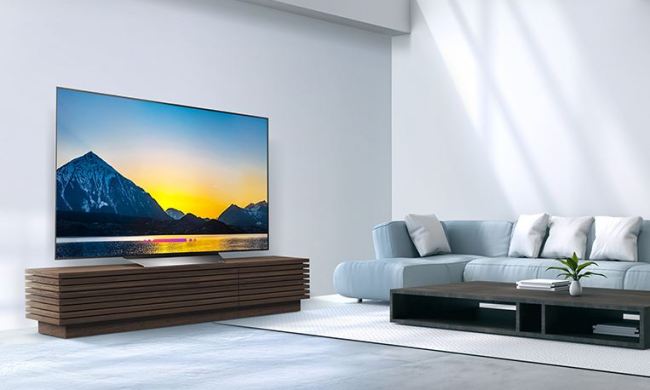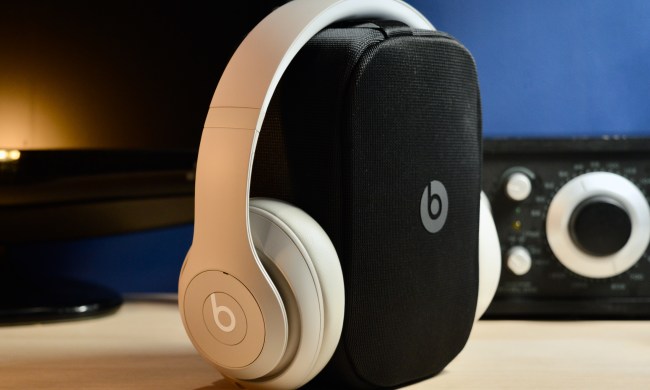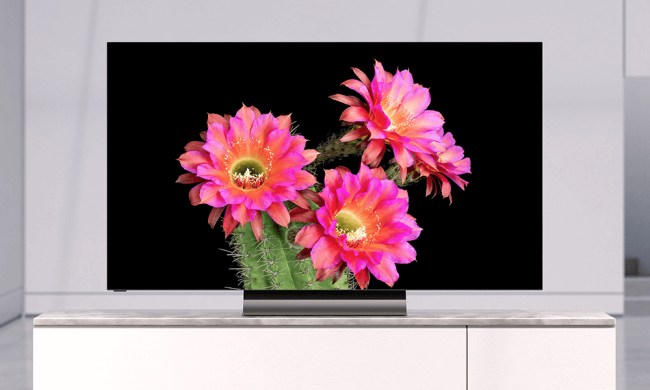“The TH-L1 is easy to set up, looks decent and works consistently.”
- Price is hard to beat; HDMI and iPod connections; attractive looking; easy to setup
- Lacks a DVD drive; unimpressive sound at high volumes; ckeap speaker construction
Summary
JVC, a well known and long-lived purveyor of consumer audio/video components, has released an all-in-one surround sound home theater speaker/receiver system, dubbed the JVC TH-L1. At roughly $299 USD, the TH-l1 supports HDMI, component and composite pass-through and has iPod and USB memory key inputs. Having tons of connections is fine, but the true test is sound quality. Read our review to find out if the TH-L1 rocks or crumbles. Be sure to check out our TH-L1 video as well.
Features and Design
The TH-L1 boasts 360 watts total RMS power. That’s a lot for a compact home theater sound system. The subwoofer puts out 100 watts for heavy duty boom-shaka-boom. The front speakers put out 40 watts each, and so do the surround speakers. The center channel is also 40 watts, making a nice round 360 watt figure. The major weakness hidden beneath all that wattage is the 10% THD, or Total Harmonic Distortion. In comparison, higher end speakers have less than 0.05% THD. When cranking the volume up on the TH-L1, you can clearly hear the THD come into play.
The TH-L1, with its five speakers and subwoofer, obviously supplies 5.1 surround sound (each channel being “1” and the subwoofer being the”.1″). If your sound source (an iPod with mp3 audio) does not have 5.1 channel audio to play, the TH-L1 will either play in stereo or can be set up (quickly and easily) to mock a 5.1 surround signal. There are several 5.1 modes to select from (Dolby Digital, DTS and Dolby Pro Logic II), each of which delivers a different sound stage. The TH-L1 has a “game mode” sound setting for XBOX, PS3, etc.
The front of the JVC TH-L1
The USB port allows you to connect USB media, whether audio (MP3, WAV and WMA) and video/still (JPEG and MPEG-1, -2 and -4). DRM protected WMA files are not supported. Browsing for files from the USB-connected device is easy, but the selection process is unintuitive and time consuming.
The TH-L1 also supports video for use with a DVD player, cable TV box, etc. This is a major feature of the system (and your home theater setup). The HDMI ports can provide up to 1080p resolution and uses Progressive Scan. The HDMI will not up-convert analog sources, however.
As for connections, the TH-L1 is very generous. There are two HDMI inputs and one HDMI out (pass-through, like an HDMI switch), two component inputs and one out (also pass-through), three analog (RCA) in/out, a digital audio in/out, S-Video in/out, USB connection, iPod connection (with proprietary cable input), and a standard 1/8″ headphone jack.
The back of the JVC TH-L1
The included remote is handy, controls all TH-L1 functions and works from a fair distance, however it feels small in the hand and has a great number of very tiny buttons and very small text descriptions for each. On the bright side, the remote can be programmed to control other common components. This turns the TH-L1 remote into a universal remote of sorts, but certainly not a high class or high-tech universal remote.
Unfortunately, JVC hasn’t really updated the old school layout of wire connectors, wires and (non-existent) color coding on this system. The TH-L1 connections look like the same jacks and thin flimsy wires used on inexpensive systems from the 1970’s. The exposed particle board frame for the sub certainly doesn’t help sell the TH-L1 to style-conscious consumers.
In stark contrast to the speaker cabinets and wiring, the body of the receiver is quite nice and modern – at least on the front. The slick, glossy plastic body reminds us of some of HP’s newer computer systems. The buttons and knobs are equally stylish. They’re not uber-chic like something you’d find on a Bang & Olufsen component, but they’re quite nice. Everything seems properly arranged and even the digital display is aesthetically colored to compliment the receiver and your home theater system.
The front of the JVC TH-L1
The receiver weighs about 6 1/2 lbs and is roughly 5″ x 11″ x 10″, so it’ll fit easily on a small TV stand, bookshelf system or desk without hogging too much space.
The subwoofer has a frequency response range of 30Hz to 1.5kHz. Many subs offer deeper bass, however the TH-L1’s bass is substantial. The sub weighs about 6 1/2 lbs and is just a little larger than the receiver, measuring about 10 1/2″ x 11″ x 6 1/2″.
Each of the front, surround and center speakers has a frequency response range of 90Hz to 20kHz, which is nice. They’re small, too – about 4″ x 4 1/8″ x 4 1/2″ – and weigh just under 1lb.
JVC TH-L1 satellite speaker
One really nice feature of the TH-L1 is its ability to control volume levels per individual speaker. If you feel that the right front speaker is just a wee bit too quiet, turn that speaker up a notch or two while leaving the other speakers alone. Same goes for the center and subwoofer. This is a great feature, something more systems should offer.
JVC includes an iPod adapter cable and an iPod stand with the TH-L1.
Setup and Use
Setting up the TH-L1 is pretty easy, but with a dozen parts to plug in and set up in your TV room, you may need to grab the instruction manual to make sure you’ve got all the wires plugged into the right jacks. In our test, total setup time was roughly 10 minutes. We did not wall mount the speakers, however, which would have taken much more time.
The instruction manual is pretty self-explanatory. Pull all the parts from the box and lay them out in a neat line. It’s necessary to pull the opaque plastic covers off the satellite speakers so you can see which are fronts and which are surrounds. All the speakers look identical, and you’ll have to tell them apart by the small sticker on the rear of each.
Plug the main receiver into a wall outlet, but hold off on powering the system up. Connect the subwoofer, center, surrounds and front speakers to the corresponding jacks on the back of the receiver.
Connect your a/v components next, whether a DVD player, cable TV box, gaming system or Apple TV. The TH-L1 has plenty of inputs, probably it’s most impressive physical attribute. The TH-L1 has only three active source options under the HDMI, component and composite categories, plus the USB and iPod connections. That’s five live connections available at once, but if you hook up more than three components (two HDMI devices, for example), you’ll need to do a little manual shuffling every once in a while to get the desired component to play through to the speakers or TV.
If you decide to hook your iPod up to the TH-L1, you should note that 4th and 5th gen iPods, 1st and 2nd gen nanos and minis will play audio fine, however only 5th gen iPods will play video. 4th gen iPods (aka iPod photo) can display still images on a TV. At present, the newest iPods released in 2007 (iPod touch, iPhone, new iPod classic and new iPod nano) don’t seem to push video properly. Hopefully JVC will be able to supply an adapter for these new iPods (or Apple providing an update), otherwise the TH-L1 will lose a significant consumer draw.
Once everything is hooked up and music is playing, it’s very apparent that the TH-L1 handles audio proficiently at low-to-mid volume levels. The surround (and simulated surround) sound works well. No matter the source, sound quality is nice. Because the satellite speakers and subwoofer can be moved around and placed in countless configurations, the sound stage is volatile – in a good way. Sound directionality and elevation can be modified, tweaked and perfected, within reason.
At default levels (speakers set at 0 attenuation), the satellites seemed soft and the subwoofer overbearing and thick. A little correction renders a much better music experience. Trouble only shows up when the volume levels are pushed past 50%. The 10% total harmonic distortion rears its ugly head and reduces the sound quality. Sure, the TH-L1 gets loud – really, really loud – it’s just not a clean, flawless loud.
Conclusion
The JVC TH-L1 is an adequate system for first-timers, starving students and people who want a multi-faceted system but who are on strict budgets. It’s also good for smaller home theater rooms with good acoustics. The TH-L1 is easy to set up, looks decent and works consistently. It’s not an audiophile system by any means as the sound quality is “pretty good” at best. The $299 price line for the TH-L1 is really not bad, but a few dollars more can net a better system.
Pros:
• $299 USD MSRP hard to beat
• HDMI, component, composite, USB and iPod inputs
• Nice looking receiver
• Easy setup and use
Cons:
• No built-in DVD/CD drive
• Unimpressive sounds at mid/high volumes
• Remote is packed tight with tiny buttons
• Speaker construction looks lower-end



